 Abraham Lincoln
If given the truth, the people can be depended upon to meet any national crisis...
Abraham Lincoln
If given the truth, the people can be depended upon to meet any national crisis...
 Guildford news...
for Guildford people, brought to you by Guildford reporters - Guildford's own news service
Guildford news...
for Guildford people, brought to you by Guildford reporters - Guildford's own news service
Fancy a Dip Into the Story of Britain’s Open-Air Swimming Pools?
Published on: 31 Jul, 2024
Updated on: 6 Aug, 2024
By David Rose
Here’s another topical and timely “silly season” (term for not much news around) history tale – a look at Britain’s open-air swimming pools.
I wrote this for a picture postcard collectors’ magazine a while ago, and Guildford’s two open-air swimming pools are included. Yes, that’s right, there was once another one!
It’s been said the golden age of lidos and open-air swimming pools was in the 1930s with some 169 built throughout Britain.
Pools at seaside resorts attracted holidaymakers and local alike. Many were built by local authorities while others were private ventures, especially as holiday camps became popular. Inland ones must surely have been in competition with those Victorian indoor baths, depending on the weather of course.
But what’s obvious is that many were built in the distinctive art deco style, so typical of the late 1920s and 1930s. Here are some of them illustrated with vintage picture postcards.
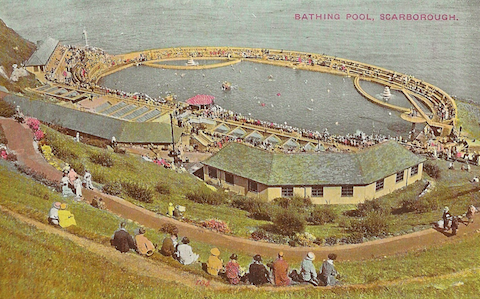
Picture postcard view of Scarborough’s South Bay pool.
At Scarborough plans were being made before the First World War for two out-door swimming pools, one each for the North and South Bays. Construction of the South Bay pool began in 1914 with it opening the following year. Its design was much a fusion of Edwardian and 1930s styles. Its dual purpose was to attract holidaymakers to the resort and to act as defence against the ravages of the North Sea.
By the 1980s it was in a terrible state and closed for good, while a bid to have the building listed and possibly saved was turned down and thus demolition took place in 2002-03. The site today is a grassy area with a large circular 26-metre diameter “star disk” of fibre-optic terminals representing the 42 brightest circumpolar stars (stars which never set) as seen from Scarborough. Its North Bay Pool opened in 1938 and closed in 2007.
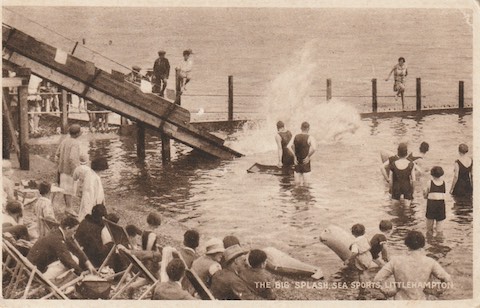
Littlehampton’s The Big Splash seawater pool.
It was in the 1920s and 30s that Littlehampton was dubbed “the children’s paradise”. A seawater swimming pool, complete with a wooden slide known as ‘The Big Splash’ was constructed in 1929, but lasted just a few years.
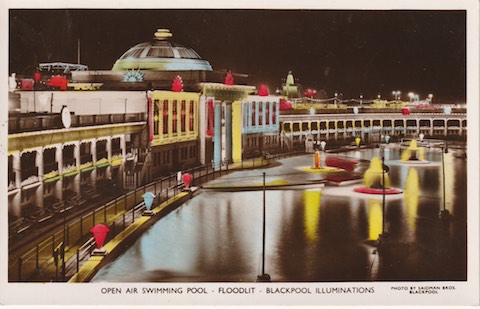
The South Shore outdoor bath at Blackpool.
Blackpool’s South Shore outdoor bath (as it was called) had an oval-shaped perimeter with the pool being D shaped. It opened to the public in 1923 and was filled with one and a half million gallons of filtered seawater. It could take 5,000 bathers and 3,000 spectators.
It too became neglected and was demolished in 1983 to be replaced by a water-based indoor leisure complex, The Sandcastle, that claims to be largest of its kind in the UK.
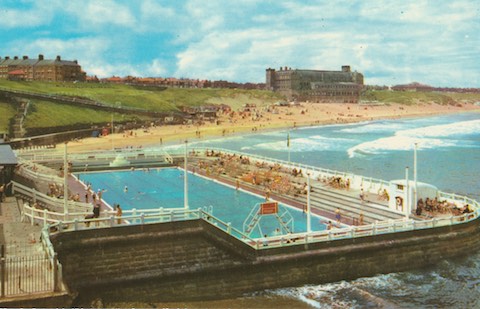
Tynemouth’s salt-water tidal pool.
At Tynemouth on England’s north-east coast, a salt-water tidal pool was constructed in the 1920s. It was popular with locals and visitors until the 1970s, by which time more and more Brits were holidaying abroad.
By the 1990s it had fallen into a sad state and the local authority spent £200,00 and demolished the buildings around the pool, bulldozing the rubble into the pool itself, filling it with concrete and boulders and turning it into an artificial rock pool.
However, in 2012 the Friends of Tynemouth Outdoor Pool was formed and its members and supporters are now working with the local authority to rebuild the pool with the cost estimated to be around £3 million.
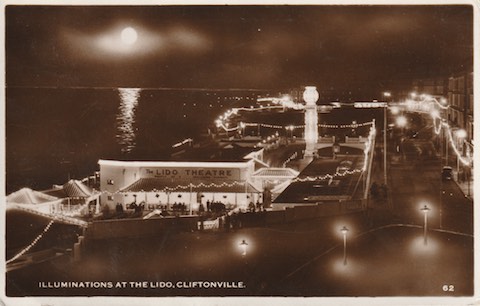
Cliftonville’s lido.
On the Kent coast at Cliftonville, next door to Margate, a lido was built in 1926 on the site of an earlier seawater bathing pool that dated from the 1820s. The new pool featured terraces for sunbathers, cafés and restaurants. It was designed by John Henry Iles, who also created Margate’s Dreamland pleasure park.
Once again it was the 1970s that saw the demise of Cliftonville Lido, with the complex being used as a disco until closing in the 1980s. However, parts of the complex (now known as Margate Lido) survive along the seafront, and there are plans to revitalise the site, reinstating the lido along with new food outlets, shops and venues for hire.
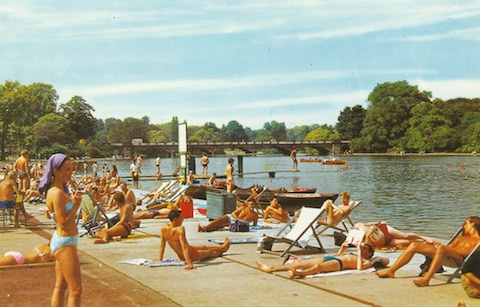
The Serpentine in London’s Hyde Park.
The Serpentine in London’s Hyde Park, an extremely well known lake and sometimes called a river, was created for recreation purposes as far back as 1730. The name Serpentine refers to the eastern half of the lake, the western half being known as the Long Water.
Its rectangular swimming area was created in 1930 and is named Lansbury’s Lido after George Lansbury, a Labour politician and social reformer who did much to improve public recreation amenities. Lansbury’s campaigning for these amenities must surely have encouraged other local authorities to follow the lead of those at coastal resorts who had already built theirs.
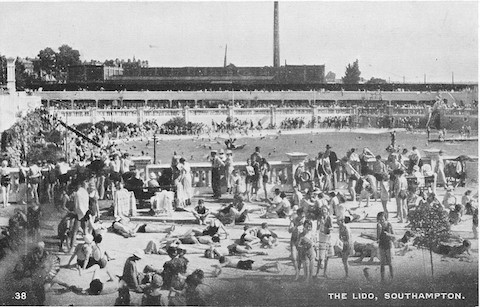
Southampton’s open-air swimming pool with the power station in the background.
Situated between a power station and a factory that manufactured cables, Southampton Lido was nonetheless a popular place for locals and visitors. An open-air public baths had been on the site since 1854, while in 1890 it was bought by Southampton Corporation and rebuilt with indoor pools for men and women.
It was revamped in 1930 with new changing rooms, terraces, a café and a filtration plant. However, polluted with soot and grit from the power station, it was closed from 1940 to 1942, reopening in 1943 after a clean-up.
It saw a resurgence of visitors during the hot summers of 1975 and 1976, but with maintenance costs rising it closed in 1977 and was demolished four years later. The area is now part of Harbour Parade that includes the West Quay shopping centre.

Plymouth’s Tinside Lido.
Situated on Plymouth Hoe is Tinside Lido, another classic salt-water pool that dates from the 1930s, and designed by architect John Wibberley. Once again, its popularity had waned by the 1980s and it closed in 1992.
To the rescue has come the Tinside Action Group. Its members gathered 70,000 signatures calling for the dilapidated pool to be reinstated, and in 2003 the pool reopened with work costing around £4.3 million.
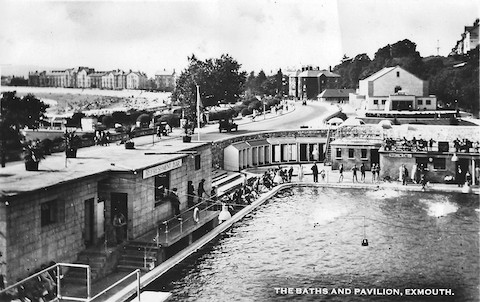
Exmouth’s open-air swimming pool.
Exmouth’s open-air swimming pool opened in 1932, originally pumping in sea water. It was the base of the Exmouth Swimming and Life Saving Society, who previously used Exmouth Docks!
A fresh water system was installed in the 1970s, but within a few years the council gave up operating the pool and a private enterprise took over before it closed in around 1985, being replaced by an indoor pool and sports centre. Today it’s the site of an entertainment venue called Ocean that features a bowling alley, soft play areas, arcade machines and places to eat and drink.
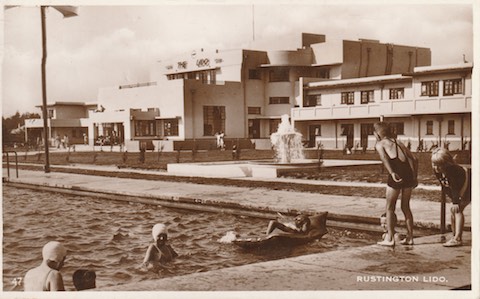
At Rustington there was the Workers’ Travel Association’s Holiday Centre complete with its own lido.
On the West Sussex coast was the Workers’ Travel Association’s Holiday Centre, Rustington Lido, a sizeable complex also in the Art Deco style.
The association was established in 1921 by trade unions and the Co-operative movement to provide affordable holidays abroad for working-class people and their families. However, it also organised holidays in Britain and the Rustington centre, that appears to have been constructed in the 1930s, would be described as a holiday village today.
It seems that after the Second World War it was renamed Mallon Dene, and possibly the only traces of it now are some walls as much of the site is now a housing estate.

Guildford Lido.
Guildford Lido was built during a time of depression and mass unemployment. The town’s Work Fund was a voluntary fund-raising project to provide paid work for unemployed men. Some of the funds that were raised paid men to build its lido.
The Work Fund was the brain child of the Mayor of Guildford, William Harvey. The lido cost the town council £13,700 to build and was officially opened on June 21 1933 by the mayor, who was the first person to dive in and take a swim.
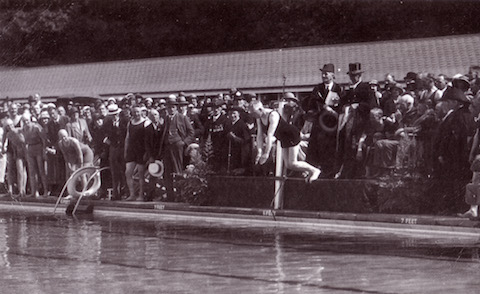
The Mayor of Guildford, William Harvey, dives into the new pool.
Guildford Lido is as popular today as it has ever been and recently has had a £2 million refurbishment as fundamentally its drainage system had failed.
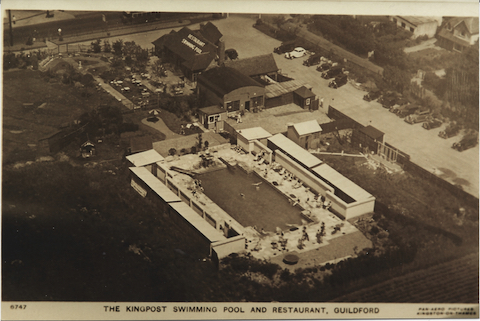
Aerial view of the Kingpost swimming pool in Burpham.
A second open-air swimming pool in Guildford also opened in 1933. It was on the outskirts of the town at Burpham. This was privately run and called the Kingpost Restaurant and Swimming Pool. However, from the outset, this self-styled country club for members was beset with problems.
In August 1936 its club secretary and manager were jointly fined £70, plus costs. They had been selling booze to non members who were allowed to dance in contravention of the licensing laws.
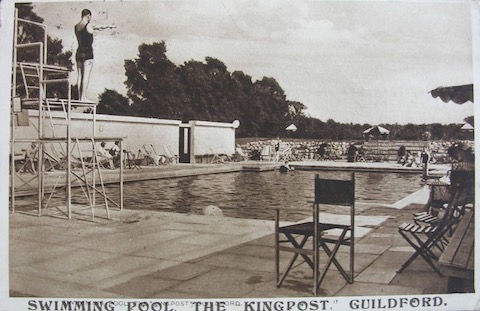
The Kingpost swimming pool in Burpham.
New owners took over who began advertising it as The Guildford Ice Rink and Sports Stadium. These plans came to nothing, and although the restaurant was re-opened briefly after the Second World War, the pool did not.
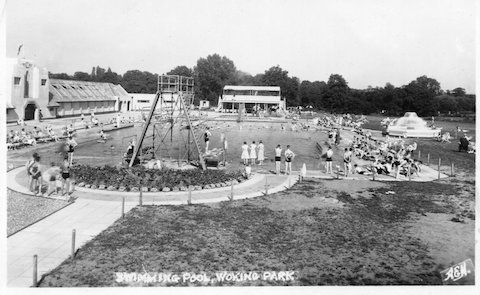
Woking’s open-air swimming pool.
A pool was constructed by Woking Urban District Council in 1935 at a cost of £21,600. Lots of concrete was used in its construction above and below ground, as the site in Woking Park had previously been a refuse tip!
Along with a sizeable area of water, there were diving boards, a cascading fountain, changing rooms and plenty of space to relax on the grass around the pool itself. It too has long gone, replaced by an indoor complex called Pool in the Park.
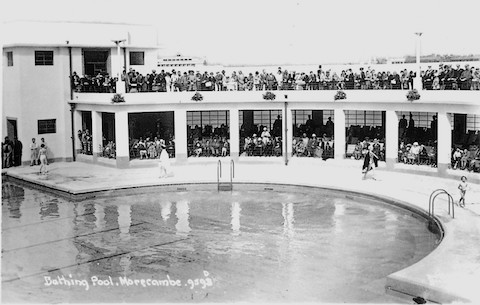
The open-air swimming pool at Morecambe.
Over on the Lancashire coast at Morecambe the corporation funded its open-air pool and called it the Super Swimming Stadium. It was opened in 1936 by the president of the London, Midland & Scottish Railway Company, Sir Josiah Stamp. He was reported to have said: “If it don’t fetch ’em in from Bradford, I don’t know what will.”
Indeed, it proved to be extremely popular and staged events featuring high diving and the first Miss Britain contest. Its downfall, that included leaks in the pool itself, resulted in it being demolished in 1977.
The latest plans agreed for the site is called Eden Project North – a multi-million pound rejuvenation eco tourist attraction being delivered by the team behind the Eden Project in Cornwall.
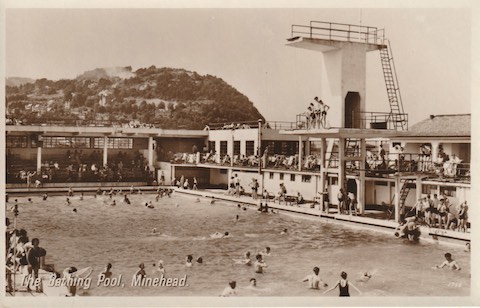
The seawater swimming pool at Minehead.
Minehead’s seawater swimming pool on the North Devon coast opened in 1936 with 2,000 people attending. It was funded by the Luttrell family who owned nearby Dunster Castle. National swimming and diving championships were held there along with flood-lit galas of water polo and diving exhibitions.
In 1958 it was bought by a group of local businessmen. Some new buildings were added including an amusement arcade. However, it appears by the 1980s it had become very run down, was soon demolished and apartments now occupy the site.

Saltdean Lido.
Opened in 1938, Saltdean Lido, near Brighton, was the work of architect Richard W. H. Jones in a ‘Streamlined Moderne’ design. It is said to epitomise some of the best elements of the modernist movement and is often regarded as one of the best surviving examples of lido design in the UK.
The lido has been brought back to life thanks to local residents who have secured a 60-year lease on the site from Brighton & Hove City Council. Their vision is to bring the building, swimming pool and grounds back into use all year round. The pool reopened to the public in 2017, and restoration work has continued on its Grade II listed Art Deco building.
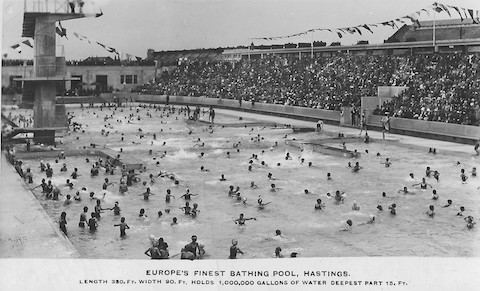
Hastings & St Leonards Bathing Pool.
The Hastings & St Leonards Bathing Pool was billed as Europe’s finest. It opened in 1933 and was 330ft long and 90ft wide. It held one million gallons of sea-water, while the deepest part was 15ft. It featured an upper deck that was used for roller skating. Only during its first year did it make a profit and it was closed in 1959.
Its outline can still be discerned as it is a grassy open space now. However, in recent years plans have been drawn up to build on the site. In November 2021, it was reported Hastings Borough Council had announced a joint venture with a developer to build homes, artists’ studios, a children’s play area, cafés, a slipway, and accommodation for tourists.
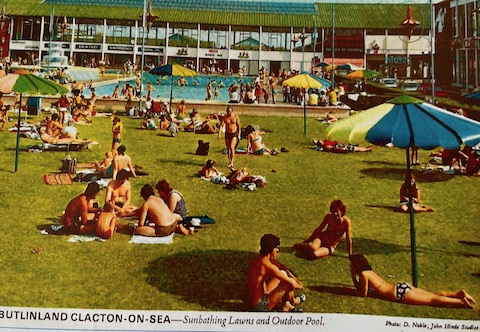
Butlin’s Clacton.
There was a lot of opposition from the people in the Essex town of Clacton in 1936 when they heard of South African-born British entrepreneur Billy Butlin’s plans for his second holiday camp there. (His first was at Skegness). It was feared the value of property in Clacton would fall and existing hoteliers would lose out.
However, it opened as a pleasure park for the 1937 summer season and as a holiday camp with accommodation the following year. Then the camp was commandeered by the military during the Second World War.
Although its halcyon days were without doubt from the late 1940s to the early 1960s, with entertainment by the likes of Roy Hudd, Dave Allen and Cliff Richard, Butlin’s Clacton saw something of a revival in the 1980s. Owned then by the Rank Organisation, its outdated holiday camp themes had long gone. But financially it was no longer viable and closed in 1983.
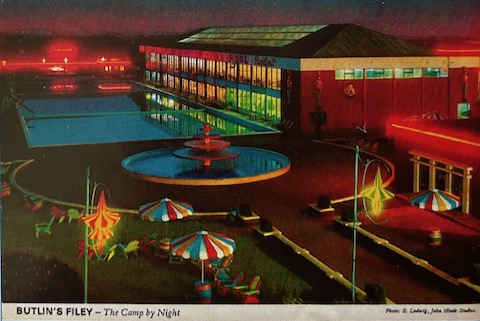
Butlin’s Filey.
Billy Butlin opened his third holiday camp at Filey on the North Yorkshire coast. Work began in 1938, and like Clacton the site was commandeered as a RAF training base during the Second World War, but “campers” poured in soon after the war.
The Filey camp could accommodate 11,000 visitors but closed in 1983, reopening briefly as Amtree Park, but by 2003 demolition was complete.
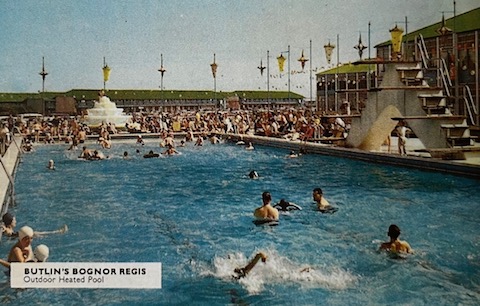
Butlin’s Bognor Regis.
Bognor Regis in West Sussex had visitor attractions courtesy of Billy Butlin as early as 1932, with his Recreation Shelter amusement park followed by the addition of a zoo and a fun fair the following year. But it was not until 1960 that a Butlin’s holiday camp was opened on a new 60-acre site, moving the existing fairground to boot!
It cost £2.5 million and could accommodate 5,000 campers. There was further investment to the tune of £16 million in 1987 during its ownership by the Rank consortium and was renamed Southcoast World. A new change of ownership in 2005 saw £10 million invested in the complex by new owners Bourne Leisure. And today it is back under the Butlin’s brand name and of course still retains a swimming pool.
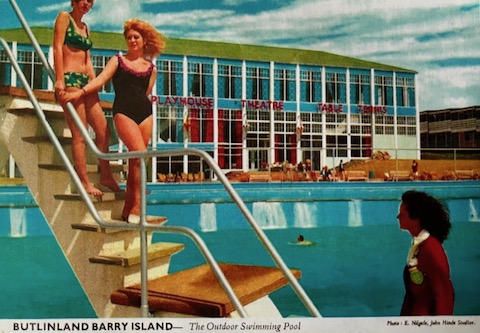
Butlin’s Barry Island.
There was an indoor as well as an outdoor pool at Butlin’s at Barry Island in South Wales, opened in 1966 and being the last and the smallest of the Butlin’s holidays camps.
In May 1987, the camp was sold to Majestic Holidays and was rebranded but it appears the chalets were in a poor state and holidaymakers were complaining. The BBC TV consumer programme That’s Life became interested and investigated with its report stating: “It’s Barry Awful”.
It also asked viewers who would be holidaying in Barry to send in a postcard. Around 8,000 did praising the holiday camp with, it’s said, only 40 complaining. It’s all long gone now and has been replaced by a housing development.
Responses to Fancy a Dip Into the Story of Britain’s Open-Air Swimming Pools?
Leave a Comment Cancel reply
Please see our comments policy. All comments are moderated and may take time to appear. Full names, or at least initial and surname, must be given.
Click on cartoon for Dragon story: Public Asked for Views on SCC’s Proposal for Reduced Speed Limits


Recent Articles
- One Homeowner Recompensed but Fight Continues Over Waverley CIL Charges
- Letter: Fine Those Guilty of Anti Social Behaviour
- GBC Working Hard To Mitigate Looming Weyside Urban Village Deficit
- Letter: Rapist Also Spearheaded Vicious Campaign Against the PCC
- Notice: Guildford Festival of the Arts – September 2025
- Police Investigating Wildlife Attacks At Fleet Pond Issue Three E-fits
- Wildlife Conservation Project Seeks To Protect Some of Surrey’s Rarest Habitats
- Dragon Interview: What’s Reform Guildford’s View of Local Government Reorganisation?
- ‘Astonishingly Clever’ SCC Show Garden Wins Silver for Turning Parking Spaces Green
- New Air Quality Strategy to Improve Pollution Approved by Guildford Borough Council


Recent Comments
- M Durant on Online Event Will ‘Help Residents Have Their Say On Local Government Reorganisation’
- Jim Allen on GBC Working Hard To Mitigate Looming Weyside Urban Village Deficit
- Tony Harrison on Letter: A Simple Footbridge Should Have Been Affordable to Keep Towpath Over Weir Open
- David Lee on Making History As Pewley School’s Class of ’54 Hold Their Final Reunion
- David Milne on GBC Asks Residents for Views on Its Draft Building Height Guidance
- Nigel Crutchley on Drivers Caught in Yellow Box Junctions at the Dennis Roundabout Paid £81k to SCC
Search in Site
Media Gallery
Dragon Interview: Local Artist Leaves Her Mark At One of England’s Most Historic Buildings
January 21, 2023 / No Comment / Read MoreDragon Interview: Lib Dem Planning Chair: ‘Current Policy Doesn’t Work for Local People’
January 19, 2023 / No Comment / Read MoreA3 Tunnel in Guildford ‘Necessary’ for New Homes, Says Guildford’s MP
January 10, 2023 / No Comment / Read More‘Madness’ for London Road Scheme to Go Ahead Against ‘Huge Opposition’, Says SCC Leader
January 6, 2023 / No Comment / Read MoreCouncillor’s Son Starts Campaign for More Consultation on North Street Plan
December 30, 2022 / No Comment / Read MoreCounty Council Climbs Down Over London Road Works – Further ‘Engagement’ Period Announced
December 14, 2022 / No Comment / Read MoreDragon Interview: GBC Reaction to the Government’s Expected Decision to Relax Housing Targets
December 7, 2022 / No Comment / Read MoreHow Can Our Town Centre Businesses Recover? Watch the Shop Front Debate
May 18, 2020 / No Comment / Read More






Tim Down
July 31, 2024 at 3:52 pm
Aldershot Lido is still open for part of the summer and yesterday (July 30) in the sun and 32C they had about 3,000 visitors. In my youth (the 1950s) it was the “go to” summer holiday destination.
I think I was told that it was used for an event in the post-war Olympics?